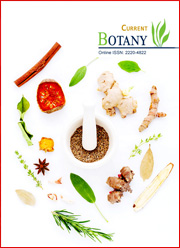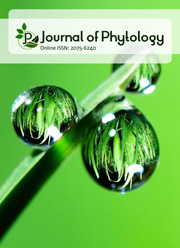Antibacterial and antifungal activities from leaf and bark extract of Cassine glauca (Rottb.) Kuntze
DOI:
https://doi.org/10.25081/cb.2025.v16.9510Keywords:
Cassine glauca, Anti-microbial, Medicinal plant, MoleculesAbstract
Practical knowledge of traditional medicine from ancient times, medicinal plants, often known as medicinal herbs, have an extensive history. Plants produce hundreds of different kinds of chemicals to serve various purposes, such as defense and protection against pathogens, fungi, insects, and herbivorous mammals.The present study investigates the antibacterial and antifungal potential of Cassine glauca leaves and bark extract. The antimicrobial activity was to find out in the extracts by using the agar disc diffusion method. Chloroform, ethanol and ethyl acetate extracts were obtained from the leaves and bark. It showed that antimicrobial activity against tested microbes from the four bacterial strains such as Staphylococcus aureus (MTCC 9542), E. coli (MTCC 732), Klebsiella pneumonia (MTCC 3040) and Proteus vulgaris (MTCC 7299) and three fungal strains such as Aspergillus niger (MTCC 1785), Aspergillus versicolor (MTCC 280) and Candida albicans (MTCC3958). The zone of inhibition of leaf and bark extracts were compared with standards like Ampicillin, Methicillin, and Norfloxacin for antibacterial and Terbinafine and nystatin for antifungal activity. The antimicrobial study result reveals that good inhibition of the bacterial and fungal grown against the tested microbes. The antimicrobial activity showed that to justify the use of their plant in traditional medicine and the practice of supplementary decoction.
Downloads
References
Adem, Y., Yesuf, K., Getachew, S., & Derbie, K. (2024). Phytochemical property and antimicrobial activity of Ficifolius A. Rich root extract: Advancing Ethiopian indigenous wart curing medicinal plant. Heliyon, 10(11), e31921. https://doi.org/10.1016/j.heliyon.2024.e31921
Berahou, A., Auhmani, A., Fdil, N., Benharref, A., Jana, M., & Gadhi, C. A. (2007). Antibacterial activity of Quercus ilex bark’s extracts. Journal of Ethnopharmacology, 112(3), 426-429. https://doi.org/10.1016/j.jep.2007.03.032
Braga, L. C., Shupp, J. W., Cummings, C., Jett, M., Takahashi, J. A., Carmo, L. S., Chartone-Souza, E., & Nascimento, A. M. A. (2005). Pomegranate extract inhibits Staphylococcus aureus growth and subsequent enterotoxin production. Journal of Ethnopharmacology, 96(1-2), 335-339. https://doi.org/10.1016/j.jep.2004.08.034
Chavan, R. T., Kalane, V. J., & Deshmukh, V. L. (2011). In vitro antimicrobial activity of Cassia tora L. stem. Current Botany, 2(1), 8-9.
Cowan, M. M. (1999). Plant products as antimicrobial agents. Clinical Microbiology Reviews, 12(4), 564-582. https://doi.org/10.1128/cmr.12.4.564
Das, S., Vasudeva, N., & Sharma, S. (2014). Chemical composition of ethanol extracts of Macrotyloma uniflorum (Lam) verdc. using GC-MS spectroscopy. Organic and Medicinal Chemistry Letters, 4, 13. https://doi.org/10.1186/s13588-014-0013-y
Doughari, J. H., Pukuma, M. S., & De, N. (2007). Antibacterial effects of Balanites aegyptiaca L. Drel. and Moringa oleifera Lam. on Salmonella typhi. African Journal of Biotechnology, 6(19), 2212-2215. https://doi.org/10.5897/AJB2007.000-2346
Duarte, A. E., De Menezes, I. R. A., Bezerra, M., Braga, M. F. B. M., Leite, N. F., Barros, L. M., Waczuk, E. P., da Silva, M. A. P., Boligon, A., Rocha, J. B. T., Souza, D. O., Kamdem, J. P., Coutinho, H. D. M., & Burger, M. E. (2016). Antimicrobial activity and modulatory effect of essential oil from the leaf of Rhaphiodon echinus (Nees & Mart) Schauer on some antimicrobial drugs. Molecules, 21(6), 743. https://doi.org/10.3390/molecules21060743
Duffy, C. F., & Power, R. F. (2001). Antioxidant and antimicrobial properties of some Chinese plant extracts. International Journal of Antimicrobial Agents, 17(6), 527-529. https://doi.org/10.1016/s0924-8579(01)00326-0
Elegami, A. A., Elnima, E. I., Muddathir, A. K., & Omer, M. E. (2001). Antimicrobial activity of Plicosepalus acacia. Fitoterapia, 72(4), 431-434. https://doi.org/10.1016/s0367-326x(01)00268-4
Friedman, M., Henika, P. R., Levin, C. E., & Mandrell, R. E. (2004). Antibacterial activities of plant essential oils and their components against Escherichia coli O157:H7 and Salmonella enterica in apple juice. Journal of Agricultural and Food Chemistry, 52(19), 6042-6048. https://doi.org/10.1021/jf0495340
Githiori, J. B., Athanasiadou, S., & Thamsborg S. M. (2006). Use of plants in novel approaches for control of Gastrointestinal Helminthes in Livestock with emphasis on small ruminants. Veterinary Parasitology, 139(4), 308-320. https://doi.org/10.1016/j.vetpar.2006.04.021
Gupta, V., & Vyas, D. (2021). The Antimicrobial effect of a cyclic peptide Nostophycin isolated from wastewater cyanobacteria, Nostoc calcicola. Current Botany, 12, 94-101. https://doi.org/10.25081/cb.2021.v12.6612
Hedlund, T. E., Johannes, W. U., & Miller, G. J. (2003). Soy isoflavonoid equol modulates the growth of benign and malignant prostatic epithelial cells in vitro. The Prostate, 54(1), 68-78. https://doi.org/10.1002/pros.10137
Kalemba, D., & Kunicka, A. (2003). Antibacterial and antifungal properties of essential oils. Current Medicinal Chemistry, 10(10), 813-829. https://doi.org/10.2174/0929867033457719
Karar, M. G. E., & Kuhnert, N. (2017). Herbal drugs from Sudan: traditional uses and phytoconstituents. Pharmacognosy Review, 11(22), 83-103. https://doi.org/10.4103/phrev.phrev_15_15
Liu, X., Min, C., Xia-shi, L., & Chungchu, L. (2008). Research on some functions of Azolla in CELSS system. Acta Astronautica, 63(7-10), 1061-1066. https://doi.org/10.1016/j.actaastro.2008.03.001
Mamarasulov, B., Davranov, K., Umruzaqov, A., Ercisli, S., Alharbi, S. A., Ansari, M. J., Krivosudská, E., Datta, R., & Jabborova, D. (2023). Evaluation of the antimicrobial and antifungal activity of endophytic bacterial crude extracts from medicinal plant Ajuga turkestanica (Rgl.) Brig (Lamiaceae). Journal of King Saud University - Science, 35(4), 102644. https://doi.org/10.1016/j.jksus.2023.102644
Mathur, M., & Kamal, R. (2012). Studies on trigonelline from Moringa oleifera and its in vitro regulation by feeding precursor in cell cultures. Brazilian Journal of Pharmaceutical Sciences, 22(5), 994-1001. http://doi.org/10.1590/S0102-695X2012005000041
Moglad, E. H. O., Boon, S. K. A., & Ali, H. T. O. (2020). Various medicinal plants: a promising treatment for multidrug-resistant bacteria isolated from wound infection. International Journal of Pharmaceutical Sciences and Research, 11(2), 839-843. https://doi.org/10.13040/IJPSR.0975-8232.11(2).839-43
Ogbulie, J. N., Ogueke, C. C., Okoli, I. C., & Anyanwu, B. N. (2007). Antibacterial activities and toxicological potentials of crude ethanolic extracts of Euphorbia hirta. African Journal of Biotechnology, 6(13), 1544-1548.
Parveen, S., Shahzad, A., Upadhyay, A., & Yadav, V. (2016). Gas chromatography- Mass spectrometry analysis of methanolic leaf extract of Cassia angustifolia Vahl. Asian Journal of Pharmaceutical and Clinical Research, 9(3), 111-116. https://doi.org/10.22159/ajpcr.2016.v9s3.14512
Pirbalouti, A. G., Chaleshtori, A. R., Tajbakhsh, E., Momtaz, H., Rahimi, E., & Shahin, F. (2009). Bioactivity of medicinal plant extracts against Listeria monocytogenes. Journal of Food Agriculture and Environment, 7(1), 66-69.
Qader, M. K., Khalid, N. S., & Abdullah, A. M. (2013). Antibacterial activity of some plant extracts against clinical pathogen. International Journal of Microbiology and Immunology Research, 1(5), 53-56.
Samoisy, A. K., & Mahomoodally, M. F. (2015). Ethnopharmacological analysis of medicinal plants used against non-communicable diseases in Rodrigues Island, Indian Ocean. Journal of Ethnopharmacology, 173, 20-38. https://doi.org/10.1016/j.jep.2015.06.036
Sapkota, R., Dasgupta, R., & Naney, & Rawat, D. S. (2012). Antibacterial effects of plant extracts on human microbial pathogens and microbial limit tests. International Journal of Research in Pharmacy and Chemistry, 2(4), 926-936.
Satish, S., Raveesha, K. A., & Janardhana, G. R. (1999). Antimicrobial activity of Plant extracts of phyto pathogenic Xanthomonas campestris pathovars. Letters in Applied Microbiology, 28(2), 145-147. https://doi.org/10.1046/j.1365-2672.1999.00479.x
Sheikh, M. I., Islam, S., Rahman, A., Rahman, M., Rahman, M., Rahman, M., Rahim, A., & Alam, F. (2010). Control of some human pathogenic bacteria by seed extracts of cumin (Cuminum cyminum L.). Agriculturae Conspectus Scientificus, 75(1), 39-44.
Shereen, M. A., Ahmad, A., Khan, H., Satti, S. M., Kazmi, A., Bashir, N., Shehroz, M., Hussain, S., Ilyas, M., Khan, M. I., Niyazi, H. A., & Zouidi, F. (2024). Plant extract preparation and green synthesis of silver nanoparticles using Swertia chirata: Characterization and antimicrobial activity against selected human pathogens. Heliyon, 10(6), e28038. https://doi.org/10.1016/j.heliyon.2024.e28038
Singh, R. K., Nallaswamy, D., Rajeshkumar, S., & Varghese, S. S. (2025). Green synthesis of silver nanoparticles using neem and turmeric extract and its antimicrobial activity of plant mediated silver nanoparticles. Journal of Oral Biology and Craniofacial Research, 15(2), 395-401. https://doi.org/10.1016/j.jobcr.2025.02.005
Sofowora, A. (1982). Medicinal plants and traditional Medicine in Africa. (2nd ed.). Hoboken, New Jersey: John Wiley & Sons Ltd.
Sreelatha, S., & Padma, P. R. (2009). Antioxidant activity and total phenolic content of Moringa oleifera leaves in two stages of maturity. Plant Foods for Human Nutrition, 64, 303-311. https://doi.org/10.1007/s11130-009-0141-0
Strohl, W. R. (2000). The role of natural products in a modern drug discovery program. Drug Discovery Today, 5(2), 39-41. https://doi.org/10.1016/S1359-6446(99)01443-9
Sun, L., Dong, H., Guo, C., Quian, J, Sun, J., Ma, L., & Zhu, C. (2006). Larvicidal activity of extracts of Ginkgo biloba exocarp for three different strains of Culex pipieus palleus. Journal of Medical Entomology, 43(2), 258-261.
Tiwari, B. K., Valdramidi, V. P., O’Donnell, C. P., Muthukumarappan, K., Bourke, P., & Cullen, P. J. (2009). Application of natural antimicrobials for food preservation. Journal of Agricultural and Food Chemistry, 57(14), 5987-6000. https://doi.org/10.1021/jf900668n
Venkatachalam, M. R., & Jebasan, A. (2001). Larvicidal activity of Hydrocotyl javanica Thumb. (Apiaceae) extracted against Culex quinquefaciatus. Journal of Experimental Zoology-India, 4, 99-101.
Verma, D. K., Bharat, M., Nayak, D., Shanbhag, T., Shanbhag, V., & Rajput, R. S. (2012). Areca catechu: Effect of topical ethanolic extract on burn wound healing in albino Rats. International Journal of Pharmacology and Clinical Sciences, 1(3), 74-78.
Yang, C. S., Landau, J. M., Huang, M.-T., & Newmark, H. L. (2001). Inhibition of carcinogenesis by dietary polyphenolic compounds. Annual Review of Nutrition, 21, 381-406. https://doi.org/10.1146/annurev.nutr.21.1.381
Zammit, M., Shoemake, C., Attard, E., & Azzopardi, L. (2014). The effect of anabasine and the alkaloid extract of Nicotiana glauca on Lepidopteros larvae. International Journal of Biology, 6(3), 46-53. https://doi.org/10.5539/ijb.v6n3p46
Published
How to Cite
Issue
Section
Copyright (c) 2025 K. Dhanasekaran, Kishore Kumar Ashok, V. Balakrishnan

This work is licensed under a Creative Commons Attribution-NonCommercial 3.0 Unported License.



 .
.